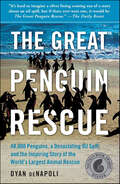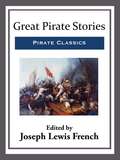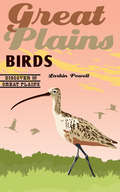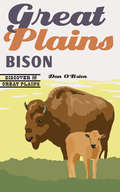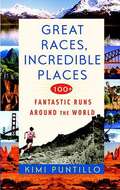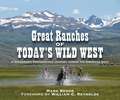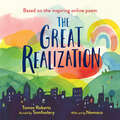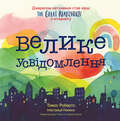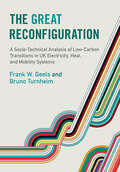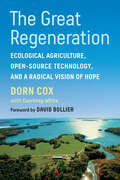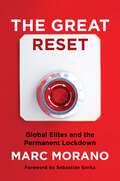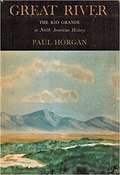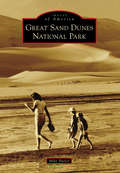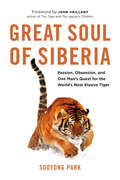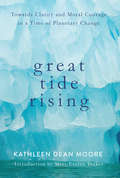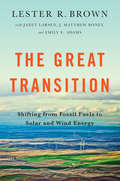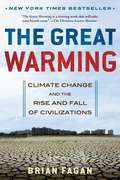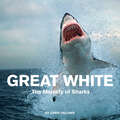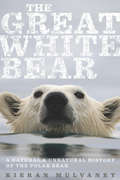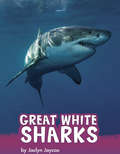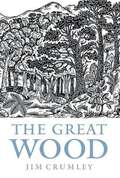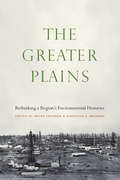- Table View
- List View
The Great Penguin Rescue: 40,000 Penguins, a Devastating Oil Spill, and the Inspiring Story of the World's Largest Animal Rescue
by Dyan deNapoliON JUNE 23, 2000, the iron-ore carrier MV Treasure, en route from Brazil to China, foundered off the coast of Cape Town, South Africa, spilling 1,300 tons of oil into the ocean and contaminating the habitat of 75,000 penguins. Realizing thJuneat 41 percent of the world’s population of African penguins could perish, local conservation officials immediately launched a massive rescue operation, and 12,500 volunteers from around the globe rushed to South Africa in hopes of saving the imperiled birds.Serving as a rehabilitation manager during the initial phase of the three-month rescue effort, Dyan deNapoli—better known as "the Penguin Lady" for her extensive work with penguins—and fellow volunteers de-oiled, nursed back to health, and released into the wild nearly all of the affected birds. Now, at the tenth anniversary of the disaster, deNapoli recounts this extraordinary true story of the world’s largest and most successful wildlife rescue. When she first entered the enormous warehouse housing most of the 19,000 oiled penguins, the birds’ total silence told deNapoli all she needed to know about the extent of their trauma. African penguins are very vocal by nature, prone to extended fits of raucous, competitive braying during territorial displays and pair-bonding rituals, but these poor creatures now stood silently, shoulder to shoulder, in a state of shock. DeNapoli vividly details the harrowing rescue process and the heartbreaking scenarios she came up against alongside thousands of volunteers: unforgettable images of them laboriously scrubbing the oil from every penguin feather and force-feeding each individually; the excruciatingly painful penguin bites every volunteer received; and the wrenching decisions about birds too ill to survive. She draws readers headfirst into the exhausting physical and emotional experience and brings to life the cast of remarkable characters—from Big Mike, a compassionate Jiu-Jitsu champion with a booming voice, who worked every day of the rescue effort; to a man named Welcome, aka "the Penguin Whisperer," who had the amazing ability to calm any penguin he held in his arms; to Louis, a seventeen-year-old medical student who created a new formula for the highly effective degreaser used by the rescue mission—whose historic and heroic efforts saved the birds from near extinction. The extraordinary international collaboration of scientists, zookeepers, animal rescue groups, and thousands of concerned individuals helped save the African penguins—recently declared an endangered species—from an all-too-common man-made disaster.DeNapoli’s heartwarming and riveting story is not just a portrait of these captivating birds, nor is it merely a cautionary tale about the environment. It is also an inspirational chronicle of how following one’s passion can lead to unexpected, rewarding adventures—and illustrates not only how people from around the world can unite for a greater purpose, but how they can be extraordinarily successful when doing so. The Great Penguin Rescue will inspire readers to believe they can make a difference
Great Pirate Stories
by Joseph Lewis FrenchSet sail for adventure. Out of this past the pirate emerges as a romantic, even at times heroic, figure. This final niche, despite his crimes, cannot altogether be denied him. A hero he is and will remain so long as tales of the sea are told. So, have at him, in these pages! Here are seventeen tails of swashbuckling adventure full of courage and danger!
Great Plains Birds (Discover the Great Plains)
by Larkin PowellThe Great Plains is a well-known and well-studied hybrid zone for many animals, most notably birds. In Great Plains Birds Larkin Powell explores the history, geography, and geology of the plains and the birds that inhabit it. From the sandhill crane to ducks and small shorebirds, he explains migration patterns and shows how human settlements have affected the movements of birds. Powell uses historical maps and images to show how wetlands have disappeared, how grasslands have been uprooted, how rivers have been modified by dams, and how the distribution of forests has changed, all the while illustrating why grassland birds are the most threatened group of birds in North America. Powell also discusses conservation attempts and how sporting organizations have raised money to create wetland and grassland habitats for both game and nongame species.Great Plains Birds tells the story of the birds of the plains, discussing where those birds can be found and the impact humans have had on them.
Great Plains Bison (Discover the Great Plains)
by Dan O'BrienGreat Plains Bison traces the history and ecology of this American symbol from the origins of the great herds that once dominated the prairie to its near extinction in the late nineteenth century and the subsequent efforts to restore the bison population. <p><p> A longtime wildlife biologist and one of the most powerful literary voices on the Great Plains, Dan O’Brien has managed his own ethically run buffalo ranch since 1997. Drawing on both extensive research and decades of personal experience, he details not only the natural history of the bison but also its prominent symbolism in Native American culture and its rise as an icon of the Great Plains. Great Plains Bison is a tribute to the bison’s essential place at the heart of the North American prairie and its ability to inspire naturalists and wildlife advocates in the fight to preserve American biodiversity.
The Great Quest: A Romance Of 1826, Wherein Are Recorded The Experiences Of Josiah Woods Of Topham, And Of Those Others With Whom He Sailed For Cuba And The Gulf Of Guinea
by Charles Boardman HawesThe story opens in Massachusetts in 1826. After Neal Gleazen unexpectedly returns to town, he involves childhood friend Seth Woods and Seth&’s nephew, twenty-year-old Joe, in a dangerous sea journey to retrieve a hidden treasure. But everything is not as it seems and Joe and Seth must come to terms with the truth and make the right choices or all will be lost. A Newbury Medal Nominee
Great Races, Incredible Places: 100+ Fantastic Runs Around The World
by Kimi Puntillo"Running the Mount Everest Marathon is like running in heaven."Kimi Puntillo has literally run around the globe to bring over 100 of the world's most entertaining, breathtaking, and unforgettable races to runners of every capability.Ranging from marathons to one-milers, from the pristine glaciers of Antarctica to Vermont's covered bridges, two-time Guinness World Record holder Puntillo offers practical and unique advice as only a woman who has run a marathon on every continent can. She shares her tips for the most desirable gear, snacks to carry in your backpack, how savvy runners get into events that are sold out months in advance, and the best local sights to take in on your downtime. Try the Great Wall Marathon, where you'll climb 60,000 steps, crawl through ancient tower windows, and follow in the footsteps of ancient Chinese history. The Marathon du Médoc spoils you with wine every three miles at Bordeaux's most elite châteaus and fresh-shucked oysters at mile 23. Or, if music is your thing and you long for a different rock band at every mile marker, head out to the Rock 'n' Roll Marathon series in locales across the United States. Whether you want to make those running dreams come true or simply be entertained, here are dozens of running adventures sure to get your heart pumping.From the Trade Paperback edition.
Great Ranches of Today's Wild West: A Horseman's Photographic Journey Across the American West
by Mark Bedor William C. ReynoldsIn this beautiful collection, veteran travel writer Mark Bedor takes readers on a journey through twenty of the great ranches of today's Wild West. With over 200 stunning full-color photographs, reading Great Ranches of Today's Wild West is almost as good as being there. Take a horseback ride through the snowy woods at Vista Verde Ranch in Steamboat Springs, Colorado, or follow in the footsteps of Butch Cassidy on the Outlaw Trail at Utah's Tavaputs Ranch-it's all just another part of the American ranch experience.
The Great Realization
by Tomos Roberts (Tomfoolery)Selected by Today as a book "to ease kids’ anxiety about coronavirus.”We all need hope. Humans have an extraordinary capacity to battle through adversity, but only if they have something to cling onto: a belief or hope that maybe, one day, things will be better.This idea sparked The Great Realization. Sharing the truths we may find hard to tell but also celebrating the things—from simple acts of kindness and finding joy in everyday activities, to the creativity within us all—that have brought us together during lockdown, it gives us hope in this time of global crisis.Written for his younger brother and sister in response to the Covid-19 pandemic, Tomos Roberts’s heartfelt poem is as timely as it is timeless. Its message of hope and resilience, of rebirth and renewal, has captured the hearts of children and adults all over the globe—and the glimpse it offers of a fairer, kinder, more sustainable world continues to inspire thousands every day. With Tomos Roberts’s heartfelt poem and beautiful illustrations by award-winning artist Nomoco, The Great Realization is a profound work, at once striking and reassuring, reminding readers young and old that in the face of adversity there are still dreams to be dreamt and kindnesses to be shared and hope. There is still hope.We now call it The Great Realizationand, yes, since then there have been many.But that’s the story of how it started . . .and why hindsight’s 2020.
The Great Realization Ukrainian (Ukrainian Edition)
by Tomos Roberts (Tomfoolery)Translated by Dasha Peipon, writer, editor and teacher, who’s originally from Ukraine, and Larysa Tsilyk, a Ukrainian poet, HarperCollins Children’s Books is happy to make available in ebook format this picture book in the Ukrainian language for no charge in the hopes that it will bring joy to displaced Ukrainian children and their families.Selected by Today as a book "to ease kids’ anxiety about coronavirus.”We all need hope. Humans have an extraordinary capacity to battle through adversity, but only if they have something to cling onto: a belief or hope that maybe, one day, things will be better.This idea sparked The Great Realization. Sharing the truths we may find hard to tell but also celebrating the things—from simple acts of kindness and finding joy in everyday activities, to the creativity within us all—that have brought us together during lockdown, it gives us hope in this time of global crisis.Written for his younger brother and sister in response to the Covid-19 pandemic, Tomos Roberts’s heartfelt poem is as timely as it is timeless. Its message of hope and resilience, of rebirth and renewal, has captured the hearts of children and adults all over the globe—and the glimpse it offers of a fairer, kinder, more sustainable world continues to inspire thousands every day. With Tomos Roberts’s heartfelt poem and beautiful illustrations by award-winning artist Nomoco, The Great Realization is a profound work, at once striking and reassuring, reminding readers young and old that in the face of adversity there are still dreams to be dreamt and kindnesses to be shared and hope. There is still hope.We now call it The Great Realizationand, yes, since then there have been many.But that’s the story of how it started . . .and why hindsight’s 2020.
The Great Reconfiguration: A Socio-Technical Analysis of Low-Carbon Transitions in UK Electricity, Heat, and Mobility Systems
by Frank W. Geels Bruno TurnheimThis book is intended for researchers, policymakers, and practitioners interested in the dynamics and governance of low-carbon transitions. Drawing on the Multi-Level Perspective, it develops a whole system reconfiguration approach that explains how the incorporation of multiple innovations can cumulatively reconfigure existing systems. The book focuses on UK electricity, heat, and mobility systems, and it systematically analyses interactions between radical niche-innovations and existing (sub)systems across techno-economic, policy, and actor dimensions in the past three decades. Comparative analysis explains why the unfolding low-carbon transitions in these three systems vary in speed, scope, and depth. It evaluates to what degree these transitions qualify as Great Reconfigurations and assesses the future potential for, and barriers to, deeper low-carbon system transitions. Generalising across these systems, broader lessons are developed about the roles of incumbent firms, governance and politics, user engagement, wider public, and civil society organisations. This title is also available as Open Access on Cambridge Core.
The Great Regeneration: Ecological Agriculture, Open-Source Technology, and a Radical Vision of Hope
by Dorn CoxIn the age of climate change, food scarcity, and increasing industrialization, can a few visionary farmers find global solutions through technology and create networked, open-source regenerative agriculture at a truly transformative scale? In The Great Regeneration, farmer-technologist Dorn Cox and author-activist Courtney White explore unique, groundbreaking research aimed at reclaiming the space where science and agriculture meet as a shared human endeavor. By employing the same tools used to visualize and identify the global instability in our climate and our communities—such as satellite imagery—they identify ways to accelerate regenerative solutions beyond the individual farm. The Great Regeneration also explores the critical function that open-source tech can have in promoting healthy agroecological systems, through data-sharing and networking. If these systems are brought together, there is potential to revolutionize how we manage food production around the world, decentralizing and deindustrializing the structures and governance that have long dominated the agricultural landscape, and embrace the principles of regenerative agriculture with democratized, open-source technology, disseminating high-quality information, not just to farmers and ranchers, but to all of us as we take on the role of ecosystem stewards. In this important book, the authors present a simple choice: we can allow ourselves to be dominated by new technology, or we can harness its potential and use it to understand and improve our shared environment. The solutions we need now, they write, involve a broader public narrative about our relationship to science, to each other, and to our institutions. And we all need to understand that the choices made today will affect the generations to come. The Great Regeneration shows how, together, we can create positive and lasting change.
The Great Reset: Global Elites and the Permanent Lockdown
by Marc MoranoHere is the antidote to the left's sinister push to use a worldwide crisis to infuse our lives with the values of collasal statism and dystopian self-hatred, all accelerated by the duplicitous manipulation of the recent pandemic. From the nationally best-selling author of The Politically Incorrect Guide to Climate Change.Welcome to 2030. I own nothing, have no privacy, and life has never been better. This is the vision of the Great Reset, according to globalist leaders. While proponents of the Great Reset push slogans like &“Build Back Better,&” &“The Fourth Industrial Revolution,&” and &“A New Normal,&” the Reset is nothing short of a rebranded Soviet system, threatening to strip away property rights, restrict freedom of movement and association, and radically reshape our diets and way of life. In The Great Reset: Global Elites and the Permanent Lockdown, bestselling author and ClimateDepot.com publisher, Marc Morano, unveils the origins of the Great Reset, who is behind it, how it is being implemented, and how COVID-19 and the alleged &“climate emergency&” accelerated its imposition on the United States. Packed with telling statistics and damning quotes, The Great Reset is the essential handbook for the public, the media, and activists on how to critically analyze and expose the tyrannical policies silently strangling our liberties today.
Great River: The Rio Grande in North American History
by Paul HorganWith the skill of a novelist, and the love of a long-time resident, Paul Horgan describes the Rio Grande, its role in human history, and the overlapping cultures that have grown up alongside it or entered into conflict over the land it traverses.<P><P> Pulitzer Prize Winner
Great Sand Dunes National Park
by Mike ButlerSouthern Colorado's unique Great Sand Dunes rise to a height of 750 feet above the San Luis Valley floor and are the nation's highest dunes not adjacent to an ocean or lake. The sweeping dunes were protected as a national monument in 1932 and as a national park in 2000. From prehistoric hunter-gatherers to the historic Ute Indian tribe, inhabitants have long used the resources of the land around the dunes. Zebulon Pike was the first American explorer to witness the dunes in 1807, followed by a long procession of other explorers, ranchers, and miners. Today, visitors from around the world come to climb up and slide down the dunes in Great Sand Dunes National Park and Preserve.
Great Soul of Siberia
by John Vaillant Sooyong ParkIn The Great Soul of Siberia, renowned tiger researcher Sooyong Park tracks three generations of Siberian tigers living in remote southeastern Russia. Reminiscent of the way Timothy Treadwell (the so-called Grizzly Man) immersed himself in the lives of bears, Park sets up underground bunkers to observe the tigers, living thrillingly close to these beautiful but dangerous apex predators. At the same time, he draws from twenty years of experience and research to focus on the Siberian tigers' losing battle against poaching and diminishing habitat. Over the two years of his harrowing stakeout, Park's poignant and poetic observations of the tigers draw a fiercely compassionate portrait of these elusive, endangered creatures.
Great Tide Rising: Towards Clarity and Moral Courage in a Time of Planetary Change
by Kathleen Dean MooreEven as seas rise against the shores, another great tide is beginning to rise - a tide of outrage against the pillage of the planet, a tide of commitment to justice and human rights, a swelling affirmation of moral responsibility to the future and to Earth's fullness of life.Philosopher and nature essayist Kathleen Dean Moore takes on the essential questions: Why is it wrong to wreck the world? What is our obligation to the future? What is the transformative power of moral resolve? How can clear thinking stand against the lies and illogic that batter the chances for positive change? What are useful answers to the recurring questions of a storm-threatened time - What can anyone do? Is there any hope? And always this: What stories and ideas will lift people who deeply care, inspiring them to move forward with clarity and moral courage?
The Great Transition: Shifting from Fossil Fuels to Solar and Wind Energy
by Emily Adams Janet Larsen Lester R. Brown J Matthew RoneyThe great energy transition from fossil fuels to renewable sources of energy is under way. As oil insecurity deepens, the extraction risks of fossil fuels rise, and concerns about climate instability cast a shadow over the future of coal, a new world energy economy is emerging. The old economy, fueled by oil, natural gas, and coal is being replaced with one powered by wind, solar, and geothermal energy. The Great Transition details the accelerating pace of this global energy revolution. As many countries become less enamored with coal and nuclear power, they are embracing an array of clean, renewable energies. Whereas solar energy projects were once small-scale, largely designed for residential use, energy investors are now building utility-scale solar projects. Strides are being made: some of the huge wind farm complexes under construction in China will each produce as much electricity as several nuclear power plants, and an electrified transport system supplemented by the use of bicycles could reshape the way we think about mobility.
The Great Transition
by Campbell BruceIn the fourteenth century the Old World witnessed a series of profound and abrupt changes in the trajectory of long-established historical trends. Transcontinental networks of exchange fractured and an era of economic contraction and demographic decline dawned from which Latin Christendom would not begin to emerge until its voyages of discovery at the end of the fifteenth century. In a major new study of this 'Great Transition', Bruce Campbell assesses the contributions of commercial recession, war, climate change, and eruption of the Black Death to a far-reaching reversal of fortunes from which no part of Eurasia was spared. The book synthesises a wealth of new historical, palaeo-ecological and biological evidence, including estimates of national income, reconstructions of past climates, and genetic analysis of DNA extracted from the teeth of plague victims, to provide a fresh account of the creation, collapse and realignment of Western Europe's late medieval commercial economy.
The Great Warming: Climate Change and the Rise and Fall of Civilizations
by Brian M. FaganA breakout bestseller on how the earth's previous global warming phase reshaped human societies from the Arctic to the Sahara--a wide-ranging history with sobering lessons for our own time. From the tenth to the fifteenth century the earth experienced a rise in surface temperature that changed climate worldwide--a preview of today's global warming. In some areas, including western Europe, longer summers brought bountiful harvests and population growth that led to cultural flowering. In the Arctic, Inuit and Norse sailors made cultural connections across thousands of miles as they traded precious iron goods. Polynesian sailors, riding new wind patterns, were able to settle the remotest islands on earth. But in many parts of the world, the warm centuries brought drought and famine. Elaborate societies in western and central America collapsed, and the vast building complexes of Chaco Canyon and the Mayan Yucatán were left empty. The history of the Great Warming of a half millennium ago suggests that we may yet be underestimating the power of climate change to disrupt our lives today--and our vulnerability to drought, writes Fagan, is the "silent elephant in the room. "
Great White: The Majesty of Sharks
by Chris FallowsFor most people, sharks and fear go hand in hand. Renowned photographer and conservationist Chris Fallows maintains a more nuanced relationship with the super predator. Gasp-inducing in their immediacy and surprise, Fallows's brilliant photographs present these mighty creatures in a different light. Great White, the first publication to collect Fallows's work reveals the sublime beauty of sharks and provides a rare glimpse into the largely unseen world of great whites, hammerheads, and other breeds. Fallows captures these fearsome creatures both above water, as they intersect with humanity, and below, in their mysterious underwater domain. A one-of-a-kind portrait of the shark and a superlative study of the nature photographer's art, this collection is bound to turn heads and elicit a deep appreciation for the creatures that inhabit our oceans.
The Great White Bear: A Natural and Unnatural History of the Polar Bear
by Kieran MulvaneyPolar bears are creatures of paradox: They are white bears whose skin is black; massive predators who can walk almost silently; Arctic residents whose major problem is not staying warm, but keeping cool. Fully grown they can measure 10 feet and weigh close to 2,000 pounds, but at birth they are just 20 ounces. Creatures that may wander thousands of miles over the course of a year, they begin life in a snowdrift. Human encounters with these legendary beasts are cause for both excitement and apprehension. Tales throughout history describe the ferocity of polar bear attacks on humans; but human hunting of polar bears has exacted a far larger toll, obliging Arctic nations to try to protect their region's iconic species before it's too late. Now, however, another threat to the polar bears' survival has emerged, one that is steadily removing sea ice and the life it supports. Without this habitat, polar bears cannot exist. The Great White Bear celebrates the story of this unique species. Through a blend of history, both natural and human, through myth and reality and observations both personal and scientific, Kieran Mulvaney masterfully provides a context for readers to consider the polar bear, its history, its life, and its uncertain fate.
The Great White Shark Scientist (Scientists in the Field Series)
by Sy Montgomery Keith Ellenbogen<P>Dr. Greg Skomal, biologist and head of the Massachusetts Shark Research Program, is investigating a controversial possibility: Might Cape Cod's waters serve as a breeding ground for the great white shark, the largest and most feared predatory fish on Earth? <P>Sy Montgomery and Keith Ellenbogen report on this thrilling turning point in marine research and travel to Guadeloupe, Mexico, to get up close and personal with the sharks. This daring expedition into the realm of great whites shows readers that in order to save the planet and its creatures, we must embrace our humanity and face our greatest fears. <P><b>Winner of the 2018 Riverby Award</b>
Great White Sharks (Animals)
by Jaclyn JaycoxGreat white sharks are the largest predatory sharks in the sea! They live all over the world, have many sharp teeth, and can smell blood from miles away. Dive deep into the ocean, and find all the facts about these incredible sharks.
The Great Wood: The Ancient Forest Of Caledon
by Jim Crumley&“Tackles the legend of the . . . forest said to have once stretched from coast to coast and to have covered much of the Scottish uplands and Highlands.&” —The Herald The Great Wood of Caledon—the historic native forest of Highland Scotland—has a reputation as potent and misleading as the wolves that ruled it. The popular image is of an impassable, sun-snuffing shroud, a Highlandswide jungle infested by wolf, lynx, bear, beaver, wild white cattle, wild boar, and wilder painted men. Jim Crumley shines a light into the darker corners of the Great Wood, to re-evaluate some of the questionable elements of its reputation, and to assess the possibilities of its partial resurrection into something like a national forest. The book threads a path among relict strongholds of native woodland, beginning with a soliloquy by the Fortingall Yew, the one tree in Scotland that can say of the hey-day of the Great Wood 5,000 years ago: &“I was there.&” The journey is enriched by vivid wildlife encounters, a passionate and poetic account that binds the slow dereliction of the past to an optimistic future.&“Crumley&’s greatest talent lies in his ability to convey genuine sympathy for the wildlife he observes, and a somehow calming sense that, however much mankind might like to think itself above all that, we&’re really all just part and parcel of the same continuum . . . A great antidote to modern life.&” —Daily Record&“An engaging read.&” —BBC Wildlife Magazine&“Crumley gives unique insight into the rich history of this land.&” —Scottish Field
The Greater Plains: Rethinking a Region's Environmental Histories
by Brian Frehner Kathleen A. BrosnanThe Greater Plains tells a new story of a region, stretching from the state of Texas to the province of Alberta, where the environments are as varied as the myriad ways people have inhabited them. These innovative essays document a complicated history of human interactions with a sometimes plentiful and sometimes foreboding landscape, from the Native Americans who first shaped the prairies with fire to twentieth-century oil regimes whose pipelines linked the region to the world.The Greater Plains moves beyond the narrative of ecological desperation that too often defines the region in scholarly works and in popular imagination. Using the lenses of grasses, animals, water, and energy, the contributors reveal tales of human adaptation through technologies ranging from the travois to bookkeeping systems and hybrid wheat. Transnational in its focus and interdisciplinary in its scholarship, The Greater Plains brings together leading historians, geographers, anthropologists, and archaeologists to chronicle a past rich with paradoxical successes and failures, conflicts and cooperation, but also continual adaptation to the challenging and ever-shifting environmental conditions of the North American heartland.
